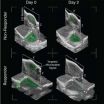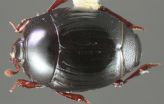(Press-News.org) A bright blue pigment used 5,000 years ago is giving modern scientists clues toward the development of new nanomaterials with potential uses in state-of-the-art medical imaging devices, remote controls for televisions, security inks and other technology. That's the conclusion of an article on the pigment, Egyptian blue, in the Journal of the American Chemical Society.
Tina T. Salguero and colleagues point out that Egyptian blue, regarded as humanity's first artificial pigment, was used in paintings on tombs, statues and other objects throughout the ancient Mediterranean world. Remnants have been found, for instance, on the statue of the messenger goddess Iris on the Parthenon and in the famous Pond in a Garden fresco in the tomb of Egyptian "scribe and counter of grain" Nebamun in Thebes.
They describe surprise in discovering that the calcium copper silicate in Egyptian blue breaks apart into nanosheets so thin that thousands would fit across the width of a human hair. The sheets produce invisible infrared (IR) radiation similar to the beams that communicate between remote controls and TVs, car door locks and other telecommunications devices. "Calcium copper silicate provides a route to a new class of nanomaterials that are particularly interesting with respect to state-of-the-art pursuits like near-IR-based biomedical imaging, IR light-emitting devices (especially telecommunication platforms) and security ink formulations," the report states. "In this way we can reimagine the applications of an ancient material through modern technochemical means."
###
The authors acknowledge funding from the University of Georgia.
The American Chemical Society is a nonprofit organization chartered by the U.S. Congress. With more than 163,000 members, ACS is the world's largest scientific society and a global leader in providing access to chemistry-related research through its multiple databases, peer-reviewed journals and scientific conferences. Its main offices are in Washington, D.C., and Columbus, Ohio.
To automatically receive news releases from the American Chemical Society, contact newsroom@acs.org.
Follow us: Twitter Facebook
Ancient 'Egyptian blue' pigment points to new telecommunications, security ink technology
2013-02-20
ELSE PRESS RELEASES FROM THIS DATE:
6 in 10 people worldwide lack access to flush toilets or other adequate sanitation
2013-02-20
It may be the 21st century, with all its technological marvels, but 6 out of every 10 people on Earth still do not have access to flush toilets or other adequate sanitation that protects the user and the surrounding community from harmful health effects, a new study has found. The research, published in ACS' journal Environmental Science & Technology, says the number of people without access to improved sanitation is almost double the previous estimate.
amie Bartram and colleagues explain that the current definition of "improved sanitation" focuses on separating humans ...
Trustworthy mating advice deepens bond between straight women and gay men
2013-02-20
Why do straight women and gay men form close relationships with one another? A new psychology study from The University of Texas at Austin suggests the glue that cements these unique relationships is honest, unbiased relationship advice.
The study, published online in the February issue of Evolutionary Psychology, is the first to provide empirical evidence that the emotional closeness shared by straight women and gay men is rooted in the absence of deceptive mating motivations.
"Friendships between straight women and gay men are free of hidden mating agendas," says ...
Preclinical study shows potential of new technologies to detect response to cancer therapy earlier
2013-02-20
The research was published early in the January issue of the journal Technology in Cancer Research and Treatment. The article describes experiments using ultrasonic molecular imaging (USMI) and Dynamic Contrast Enhanced-Perfusion Imaging (DCE-PI) to measure response to therapy for pancreatic cancer.
Paul Dayton, PhD, senior author says, "What we found is that using two non-invasive technologies, we can detect response to therapy earlier than by relying on tumor volume changes. Having new non-invasive, inexpensive technologies available to measure response to therapy earlier ...
Pitt study examines cost-effectiveness of medicare drug plans in schizophrenia and bipolar disorder
2013-02-20
PITTSBURGH, Feb. 19, 2013 – A new study published online today in the American Journal of Managed Care found that in Medicare Part D, generic drug coverage was cost-saving compared to no coverage in bipolar disorder and schizophrenia, while also improving health outcomes. Researchers from the University of Pittsburgh School of Medicine, the Pitt Graduate School of Public Health, and Western Psychiatric Institute and Clinic of UPMC note that policymakers and insurers should consider generic-only coverage, rather than no gap coverage, to both conserve health care resources ...
Using millions of gigs of data to improve human health
2013-02-20
With biomedical scientists struggling to collect and analyze millions of gigabytes of data in their efforts to improve human health, the National Institutes of Health has launched a $700 million project to develop a common data-sharing framework and start training future scientists to tap that gold mine of information. That's the topic of a story in the current edition of Chemical & Engineering News (C&EN), the weekly newsmagazine of the American Chemical Society, the world's largest scientific society.
Britt E. Erickson, C&EN senior editor, explains that biomedical researchers ...
Little did we know about beetle diversity: Astonishing 138 new species in a single genus
2013-02-20
The tropics are home to an extraordinary diversity of insect species. How great is it, exactly? We do not know, but today, researchers at the Santa Barbara Museum of Natural History published a study on tropical beetles that can help us progress towards an answer to this question. The paper was published in the open access, peer-reviewed journal Zookeys.
Entomologists Michael Caterino and Alexey Tishechkin have named 138 new species within the genus Operclipygus (the name refers to their clamshell-like rear end), thereby increasing the size of the genus over six times. ...
Potential benefits of inertial fusion energy justify continued R&D
2013-02-20
WASHINGTON -- The potential benefits of successful development of an inertial confinement fusion-based energy technology justify investment in fusion energy research and development as part of the long-term U.S. energy R&D portfolio, says a new report from the National Research Council. Although ignition of the fusion fuel has not yet been achieved, scientific and technological progress in inertial confinement fusion over the past decade has been substantial. Developing inertial fusion energy would require establishment of a national, coordinated, broad-based program, ...
Molecules assemble in water, hint at origins of life
2013-02-20
The base pairs that hold together two pieces of RNA, the older cousin of DNA, are some of the most important molecular interactions in living cells. Many scientists believe that these base pairs were part of life from the very beginning and that RNA was one of the first polymers of life. But there is a problem. The RNA bases don't form base pairs in water unless they are connected to a polymer backbone, a trait that has baffled origin-of-life scientists for decades. If the bases don't pair before they are part of polymers, how would the bases have been selected out from ...
Being stoic for the spouse's sake comes at a high cost
2013-02-20
Among life's many tragedies, the death of a child is one that is perhaps the greatest for parents. No matter what the age of the child or the cause of death, the irrefutable fact of the loss is one that shatters the normal cycle of life, leaving parents traumatized and often incapacitated by grief.
Research on coping with bereavement has focused primarily on the individual, despite the fact that family and married relationships are all profoundly disrupted by the loss. But in the wealth of studies about parental grief, little attention has been paid to precisely how couples ...
Study: Resveratrol shows promise to protect hearing, cognition
2013-02-20
DETROIT – Resveratrol, a substance found in red grapes and red wine, may have the potential to protect against hearing and cognitive decline, according to a published laboratory study from Henry Ford Hospital in Detroit.
The study shows that healthy rats are less likely to suffer the long-term effects of noise-induced hearing loss when given resveratrol before being exposed to loud noise for a long period of time.
"Our latest study focuses on resveratrol and its effect on bioinflammation, the body's response to injury and something that is believed to be the cause of ...


